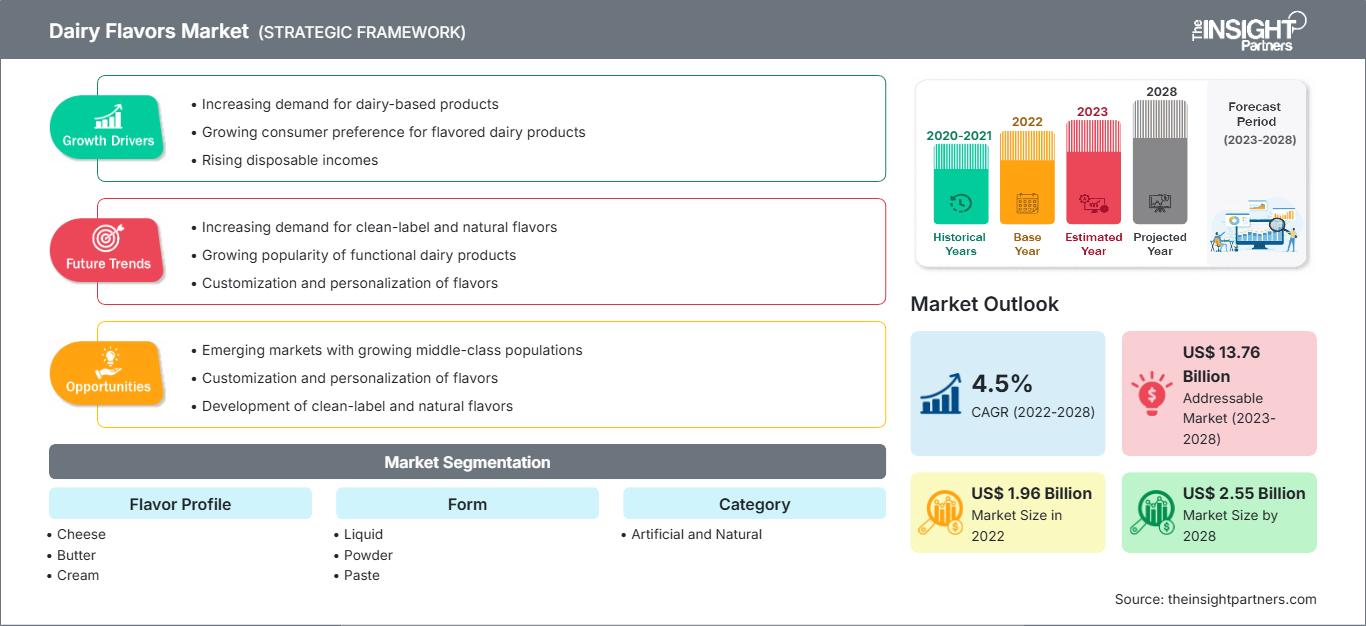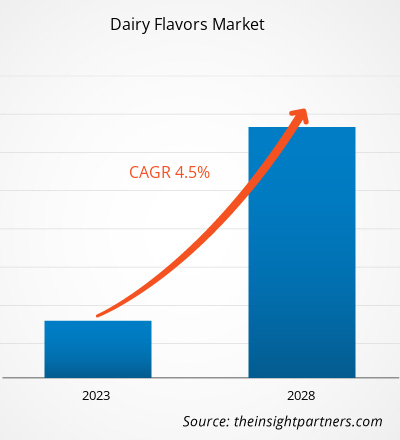Si prevede che il mercato degli aromi per latticini crescerà da 1.962,45 milioni di dollari nel 2022 a 2.552,19 milioni di dollari entro il 2028; si stima una crescita a un CAGR del 4,5% dal 2022 al 2028.
Gli aromi per latticini sono agenti aromatizzanti aggiunti a vari prodotti alimentari e bevande per conferire il sapore di prodotti lattiero-caseari come burro, formaggio, panna e latte. Gli aromi per latticini stanno guadagnando terreno nel settore alimentare e delle bevande poiché contribuiscono a conferire il sapore del latte senza aumentare le calorie o il contenuto di grassi del prodotto. Gli aromi per latticini sono lavorati e prodotti a partire da prodotti lattiero-caseari come latte, burro, formaggio e panna e sono disponibili in formato liquido, in polvere e in pasta. Questi aromi sono pensati per esaltare il gusto e l'intensità di vari prodotti alimentari, conferendo loro una varietà di profili aromatici, come burroso, formaggioso, cremoso e molti altri sapori dolci e salati. Gli aromi lattiero-caseari sono utilizzati in vari prodotti alimentari, come prodotti da forno e dolciumi, snack dolci e salati, zuppe e salse, salse e condimenti e dessert surgelati.
Nel 2021, l'Asia-Pacifico ha detenuto la quota maggiore del mercato degli aromi lattiero-caseari e si stima che registrerà il CAGR più elevato durante il periodo di previsione. La crescita del mercato in questa regione è principalmente attribuibile alla crescente consapevolezza sanitaria e alla crescente attenzione per il cibo gustoso in paesi come India, Cina e Giappone, a causa dell'aumento del reddito disponibile. In questi paesi, i consumatori sono disposti a pagare prezzi più elevati per i prodotti aromatizzati al latte. L'India si colloca come uno dei mercati in più rapida crescita nell'Asia-Pacifico, dove i consumatori non sono disposti a scendere a compromessi sul gusto e sulla salute degli alimenti. Esiste una forte domanda di sapori regionali e tradizionali provenienti dal subcontinente indiano, che sta alimentando la crescita del mercato.
Personalizza questo rapporto in base alle tue esigenze
Potrai personalizzare gratuitamente qualsiasi rapporto, comprese parti di questo rapporto, o analisi a livello di paese, pacchetto dati Excel, oltre a usufruire di grandi offerte e sconti per start-up e università
Mercato dei sapori lattiero-caseari: Approfondimenti strategici

- Ottieni le principali tendenze chiave del mercato di questo rapporto.Questo campione GRATUITO includerà l'analisi dei dati, che vanno dalle tendenze di mercato alle stime e alle previsioni.
Potrai personalizzare gratuitamente qualsiasi rapporto, comprese parti di questo rapporto, o analisi a livello di paese, pacchetto dati Excel, oltre a usufruire di grandi offerte e sconti per start-up e università
Mercato dei sapori lattiero-caseari: Approfondimenti strategici

- Ottieni le principali tendenze chiave del mercato di questo rapporto.Questo campione GRATUITO includerà l'analisi dei dati, che vanno dalle tendenze di mercato alle stime e alle previsioni.
Impatto della pandemia di COVID-19 sul mercato degli aromi lattiero-caseari
Prima della pandemia, la crescente domanda di alimenti trasformati e la crescente richiesta da parte dei consumatori di una varietà di aromi e sapori del prodotto erano i fattori chiave che hanno stimolato la crescita del mercato degli aromi lattiero-caseari. Il mercato degli aromi lattiero-caseari è stato trainato dall'industria alimentare e delle bevande che ha incorporato una varietà di aromi nei suoi prodotti. Inoltre, la tendenza dei consumatori verso gli aromi naturali e l'aumento del consumo di prodotti pronti al consumo tra la popolazione sono stati tra gli altri fattori che hanno influenzato positivamente la crescita del mercato. Tuttavia, i settori hanno dovuto affrontare sfide senza precedenti dopo l'inizio della pandemia di COVID-19 nel 2020, tra cui vincoli alla catena di approvvigionamento causati da lockdown a livello nazionale, divieti commerciali e restrizioni di viaggio. Le interruzioni della catena di approvvigionamento hanno creato una carenza di materie prime, che ha influito sulla produzione e sulla distribuzione di vari prodotti, con conseguente aumento dei prezzi.
Nel 2021, diverse economie hanno ripreso a funzionare, poiché i governi di vari paesi hanno annunciato l'allentamento delle restrizioni precedentemente imposte, con conseguente impulso al mercato globale. Inoltre, ai produttori è stato consentito di operare a piena capacità, il che li ha aiutati a superare il divario tra domanda e offerta e altre ripercussioni. Poiché numerosi cittadini di molti paesi erano stati completamente vaccinati entro il 2021, i produttori di aromi per latticini si sono concentrati sull'aumento della produzione per rilanciare le loro attività.
Approfondimenti di mercato
Gli sviluppi strategici dei principali attori favoriscono la crescita del mercato degli aromi per latticini
A giugno 2020, Edlong ha ampliato il suo segmento di aromi naturali a base di latte includendo una linea di profili ad alta intensità per formaggi e fermentati da utilizzare in salse, condimenti e intingoli. A maggio 2021, Synergy Flavors acquisisce Innova Flavors da Griffith Foods Worldwide. Questa acquisizione offre notevoli vantaggi ai clienti di Synergy, consentendo loro di accedere a una comprovata varietà di aromi per soddisfare la crescente domanda di aromi naturali e ingredienti salati. Si prevede che tali sviluppi strategici da parte dei principali attori del mercato favoriranno la crescita del mercato degli aromi per latticini. Inoltre, alcuni dei principali attori della regione sono coinvolti in strategie come fusioni e acquisizioni per espandere la propria presenza geografica.
Approfondimenti sul profilo aromatico
In base al profilo aromatico, il mercato degli aromi per latticini è segmentato in formaggio, burro, panna e altri. Il segmento del formaggio ha detenuto la quota di mercato maggiore nel 2021 e si prevede che registrerà il CAGR più elevato durante il periodo di previsione. La popolarità dell'aroma di formaggio si basa sul suo utilizzo in popcorn, patatine, biscotti, cracker, salse e creme spalmabili, tra gli altri prodotti. La crescente domanda di prodotti alimentari, l'aumento dei punti vendita al dettaglio e la crescente preferenza per il fast food stanno aumentando la richiesta di aromi al formaggio.
Approfondimenti sulle applicazioni
In base all'applicazione, il mercato degli aromi lattiero-caseari è segmentato in prodotti da forno e pasticceria; prodotti lattiero-caseari e dessert surgelati; zuppe e salse; condimenti, salse e creme spalmabili; bevande e altri. Pane, biscotti, torte e ripieni sono tra le principali applicazioni degli aromi lattiero-caseari nei prodotti da forno e pasticceria. I produttori di dolciumi utilizzano sempre più aromi naturali nei loro prodotti. Gli aromi a base di latte sono sempre più utilizzati in prodotti da forno come biscotti e torte.
Jeneil, Flavorjen, The Edlong Corporation, Givaudan SA, Kerry Group, Sensient Technologies, Symrise, Synergy Flavors, Bluegrass Ingredients Inc. e Flavorade India sono tra i principali attori che operano nel mercato degli aromi lattiero-caseari. Queste aziende si concentrano principalmente sull'innovazione di prodotto per espandere le dimensioni del loro mercato e seguire le tendenze emergenti del mercato.
Mercato dei sapori lattiero-caseari
Le tendenze regionali e i fattori che influenzano il mercato degli aromi per latticini durante il periodo di previsione sono stati ampiamente spiegati dagli analisti di The Insight Partners. Questa sezione analizza anche i segmenti e la geografia del mercato degli aromi per latticini in Nord America, Europa, Asia-Pacifico, Medio Oriente e Africa, America Meridionale e Centrale.
Ambito del rapporto di mercato sugli aromi dei latticini
| Attributo del rapporto | Dettagli |
|---|---|
| Dimensioni del mercato in 2022 | US$ 1.96 Billion |
| Dimensioni del mercato per 2028 | US$ 2.55 Billion |
| CAGR globale (2022 - 2028) | 4.5% |
| Dati storici | 2020-2021 |
| Periodo di previsione | 2023-2028 |
| Segmenti coperti |
By Profilo aromatico
|
| Regioni e paesi coperti | Nord America
|
| Leader di mercato e profili aziendali chiave |
|
Densità degli attori del mercato degli aromi lattiero-caseari: comprendere il suo impatto sulle dinamiche aziendali
Il mercato degli aromi per latticini è in rapida crescita, trainato dalla crescente domanda da parte dei consumatori finali, dovuta a fattori quali l'evoluzione delle preferenze dei consumatori, i progressi tecnologici e una maggiore consapevolezza dei benefici del prodotto. Con l'aumento della domanda, le aziende stanno ampliando la propria offerta, innovando per soddisfare le esigenze dei consumatori e sfruttando le tendenze emergenti, alimentando ulteriormente la crescita del mercato.

- Ottieni il Mercato dei sapori lattiero-caseari Panoramica dei principali attori chiave
In evidenza nel rapporto
- Tendenze progressive del settore nel mercato degli aromi per latticini per aiutare le aziende a sviluppare strategie efficaci a lungo termine
- Strategie di crescita aziendale adottate dagli operatori del mercato degli aromi per latticini nei paesi sviluppati e in via di sviluppo
- Analisi quantitativa del mercato dal 2022 al 2028
- Stima della domanda globale di aromi per latticini
- Analisi delle cinque forze di Porter per illustrare l'efficacia di acquirenti e fornitori nel mercato degli aromi per latticini
- Sviluppi recenti per comprendere lo scenario competitivo del mercato
- Tendenze e prospettive di mercato, nonché fattori che guidano e frenano la crescita del mercato degli aromi per latticini
- Assistenza nel processo decisionale evidenziando le strategie di mercato che sostengono l'interesse commerciale
- Dimensioni del mercato degli aromi per latticini in vari nodi
- Panoramica dettagliata e segmentazione del mercato e dinamiche di crescita del settore degli aromi per latticini
- Dimensioni del mercato degli aromi per latticini in varie regioni con promettenti opportunità di crescita
- Analisi storica (2 anni), anno base, previsione (7 anni) con CAGR
- Analisi PEST e SWOT
- Valore/volume delle dimensioni del mercato - Globale, Regionale, Nazionale
- Industria e panorama competitivo
- Set di dati Excel
Report recenti
Testimonianze
Motivo dell'acquisto
- Processo decisionale informato
- Comprensione delle dinamiche di mercato
- Analisi competitiva
- Analisi dei clienti
- Previsioni di mercato
- Mitigazione del rischio
- Pianificazione strategica
- Giustificazione degli investimenti
- Identificazione dei mercati emergenti
- Miglioramento delle strategie di marketing
- Aumento dell'efficienza operativa
- Allineamento alle tendenze normative




















 Ottieni un campione gratuito per - Mercato dei sapori lattiero-caseari
Ottieni un campione gratuito per - Mercato dei sapori lattiero-caseari